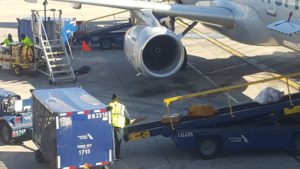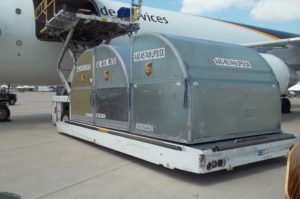USDOT/PHMSA issued an interim final rule (IFR) on March 6, 2019; its purpose: to revise the Hazardous Materials Regulations (HMR) for lithium cells and batteries transported by aircraft. In this revision the USDOT/PHMSA harmonizes its HMR with the international regulations. This rule codifies the following:
- Prohibits the transport of lithium ion cells and batteries when packed alone as cargo on passenger aircraft.
- Requires lithium ion cells and batteries to be shipped at not more than a 30% state of charge aboard cargo-only aircraft if not packed with or in the equipment it is meant to power (i.e., packed alone).
- Limits the use of the “small lithium cell or battery exception” for transport by aircraft at 49 CFR 173.185(c)(4) to one package per overpack or consignment.
- Allows for a limited exception from the above restrictions on air transportation for lithium cells or batteries in medical devices.
The purpose of this article is to identify and explain this new USDOT/PHMSA regulation for the transport of lithium cells and batteries by air.
Note: The impact of this new rule is not just limited to air transport. It affects the transport of lithium cells and batteries by other modes (highway, rail, vessel) as well. |
Before we begin…
- USDOT/PHMSA regulates the transportation of hazardous materials within the U.S. by all modes (air, highway, rail, vessel).
- International air transportation is subject to the technical instructions of the International Civil Aviation Administration (ICAO).
- Most commercial airlines – domestic and international – are members of the International Air Transport Association (IATA), which has its own Dangerous Goods Regulations. The IATA Dangerous Goods Regulations are based on the ICAO technical instructions and are more strict when they differ.
- As members of IATA, most commercial air carriers (UPS being an exception) mandate compliance with the IATA Dangerous Goods Regulations for the air transport of a hazardous material whether it be international or domestic.
- USDOT/PHMSA allows shippers and carriers of HazMat to comply with the IATA Dangerous Goods Regulations in lieu of the HMR if the following additional requirements and limitations are met:
- 49 CFR 171.22 Authorization and conditions for the use of international standards and regulations
- 49 CFR 171.23 Requirements for specific materials and packagings transported under the ICAO Technical Instructions, IMDG Code, Transport Canada TDG Regulations, or the IAEA Regulations
- 49 CFR 171.24 Additional requirements for the use of the ICAO Technical Instructions
To vastly oversimplify: The transportation of a hazardous material by air within the U.S. will likely be subject almost entirely to the IATA Dangerous Goods Regulations with only a few residual requirements of the HMR. With one exception noted in this article, the changes to the HMR made by this rule will not affect most shippers of lithium batteries.
| Note: There are two types of lithium batteries: lithium metal and lithium ion. The transport regulations for lithium metal batteries are more strict than those for lithium ion batteries. |
Scope and applicability:
- The interim final rule (IFR) was published in the Federal Register 03.06.19 (84 FR 8006). It went into effect on that same date.
- This rule will predominately affect shippers and carriers of lithium batteries as cargo on aircraft subject to the regulations of USDOT/PHMSA. However, in prohibiting the transport of lithium ion batteries as cargo on passenger aircraft the rule has created a new requirement to mark packages of lithium ion cells and batteries even when shipped by highway, rail, or vessel.
Daniels Training Services, Inc. 815.821.1550 |
Passenger aircraft prohibition:
The HMR now prohibits the transport of lithium ion batteries as cargo on passenger aircraft when not packed with or in the equipment they are meant to power (i.e., packed alone). This requires a change to the entry in the Hazardous Materials Table at 49 CFR 172.101 for UN3480, Lithium ion batteries. The table entries before and after the rule change are shown below.
Note the change to column 9A where the net quantity per package limit by passenger aircraft went from 5 kg to “Forbidden”. Also, special provision A51 in column 7 was removed and revised and special provision A100 was added (more on A100 later in this article).
A51 allowed for the transport of a single lithium ion aircraft battery with a net mass not exceeding 35 kg as cargo on a passenger aircraft. So it had to go. After removing A51, USDOT/PHMSA purged it of any reference to lithium ion batteries, though it still provides an exception from full regulation for wet cell aircraft batteries, UN2794, UN2795 as cargo on passenger aircraft.
What it means:
Not much. IATA has had a ban on the transport of lithium ion batteries packed alone as cargo on passenger aircraft since April 1, 2016 and a ban on lithium metal batteries back even further than that. Unless you ship lithium ion batteries as cargo on passenger aircraft with an air carrier that complies with the HMR and not the IATA Dangerous Goods Regulations, this change won’t mean anything to you. But we’re not done…
The new rule also created new regulations in the packing instructions for lithium batteries; specifically, within the “small lithium cell or battery exception” at 49 CFR 173.185(c)(1)(iii). Prior to March 6, 2019, this regulation required the display of specific markings on packages of solely lithium metal batteries (the HMR has prohibited lithium metal batteries as cargo on passenger aircraft since January 1, 2008) but now requires them on the following, even if the mode of transport is highway, rail, or vessel:
- All lithium batteries (ion and metal) packed alone (UN3480 or UN3090).
- All lithium batteries packed with or contained in equipment (UN3481 or UN3091) if the net weight of lithium batteries within the package exceeds 5 kg.
A subject package must now display one of the following markings:
- “PRIMARY LITHIUM BATTERIES – FORBIDDEN FOR TRANSPORT ABOARD PASSENGER AIRCRAFT”
- “LITHIUM METAL BATTERIES – FORBIDDEN FOR TRANSPORT ABOARD PASSENGER AIRCRAFT”
- “LITHIUM ION BATTERIES – FORBIDDEN FOR TRANSPORT ABOARD PASSENGER AIRCRAFT”
- Display the “CARGO AIRCRAFT ONLY” label specified in 49 CFR 172.488.
The change to the regulations is displayed in the following table.
| If the gauge pressure (psig) at 54.4 degrees C (130 degrees F) is... | Authorized container |
|---|---|
| 140 or less | Non-DOT specification DOT 2P DOT 2Q DOT 2Q1 |
| Greater than 140 but not exceeding 160 | DOT 2P DOT 2Q DOT 2Q1 |
| Greater than 160 but not exceeding 180 | DOT 2Q DOT 2Q1 |
| Not to exceed 210 | DOT 2Q1 (non-flammable only) |
What it means:
A lot! This marking requirement now applies to ALL packages of lithium batteries packed alone and ALL packages of lithium batteries packed with or contained in equipment if the net weight of lithium batteries in the package exceeds 5 kg.
This new regulation came as such a shock to the lithium battery industry that the Rechargeable Battery Association with seven other trade associations have asked USDOT/PHMSA to delay enforcement of this new mandate. Read about it here.
State of charge requirement:
The HMR now requires a lithium ion battery packed alone (UN3480) to be offered for transport at a state of charge of 30% or less of its rated capacity.
- This change is found in special provision A100 which, as shown above, was added to column 7 of the Hazardous Materials Table for the entry: UN3480, Lithium ion batteries.
- Lithium ion batteries offered for transport at a state of charge greater than 30% of their rated capacity may only be transported under an Approval issued by USDOT/PHMSA per 49 CFR 107, subpart H.
- Guidance and methodology for determining the rated capacity of a lithium battery is at sub-section 38.3.2.3 of the UN Manual of Tests and Criteria.
- This prohibition does not apply to cells and batteries packed with or contained in equipment.
What it means:
Not much. A similar requirement in the IATA Dangerous Goods Regulations applicable to both lithium ion and lithium metal batteries pre-existed this change of the HMR. The purpose of this change was merely to harmonize – at least partially – with the international regulations. (Under the HMR the state of charge requirement only applies to lithium ion batteries.)
| Tired of reading? Take a look at my YouTube channel for informative videos on these topics! |
Consignment and overpack restriction:
Under the new rule, the HMR now limits the number of packages subject to the “small lithium cell or battery exception” that may be included in consignments and overpacks shipped by air. The limit is now: no more than one subject package per consignment or overpack. Also, these packages must be offered to the operator (air carrier) separately from non-hazardous cargo and must not be loaded into the unit load device before being offered to the operator.
- These changes were codified in 49 CFR 173.185(c)(4).
- This limit applies to both lithium ion and lithium metal batteries.
- To be subject to this limit the package must be offered for transport according to the “small lithium cell or battery exception” at 49 CFR 173.185(c)(4) for transport by air. Fully-regulated lithium batteries and those transported by other modes (highway, rail, vessel) are not subject to this limit.
- An overpack or consignment of more than one package subject to the exception of 49 CFR 173.185(c)(4) must be shipped as a fully-regulated hazardous material. This would include, but not be limited to, submitting at least two copies of a shipper’s declaration of dangerous goods to the air carrier.
Note: Prior to this rule change, large numbers of “small” lithium cells or batteries in an overpack or consignment were transported by air with no notice given to the pilot(s). This rule addresses that safety deficiency. |
What it means:
Not much. The same limit appears in the IATA Dangerous Goods Regulations. This change fully harmonizes the HMR with international regulations.
Contact me with any questions you may have about the transportation of hazardous materials by air, highway, vessel, or rail International and Domestic Daniels Training Services, Inc. 815.821.1550 |
Limited exceptions to restrictions on air transportation of medical device cells or batteries:
USDOT/PHMSA will allow a limited exception for up to two lithium batteries used for medical devices to be transported on passenger aircraft, and at a state of charge higher than 30 percent, for remote areas like Alaska that do not have regular cargo service.
The addition of this exception required the creation of an entirely new paragraph of regulations at 49 CFR 173.185(g). The fact that it is not included in paragraph (c) of this section is critical; it means that the use of this limited exception is independent of the “small lithium cell or battery exception” at 49 CFR 173.185(c). It can be used for batteries subject to the exception but also for fully-regulated shipments of lithium cells or batteries.
It also required the adoption of a definition for “medical device” from IATA and including it in the first paragraph of 173.185:
Medical device means an instrument, apparatus, implement, machine, contrivance, implant, or in vitro reagent, including any component, part, or accessory thereof, which is intended for use in the diagnosis of disease or other conditions, or in the cure, mitigation, treatment, or prevention of disease, of a person.
Exception from the passenger aircraft prohibition:
Use of this exception is dependent on the following conditions and limitations:
- Applicable to both lithium ion and lithium metal batteries.
- Limited to no more than two replacement batteries if specifically used for a medical device.
- Packages need not display the marks specified in 49 CFR 173.185(c)(3)(iii) discussed earlier in this article or the “CARGO AIRCRAFT ONLY” label.
- Transport must be done under an Approval issued by USDOT/PHMSA per 49 CFR 107, subpart H.
- The intended destination of the cells or batteries is not serviced daily by cargo aircraft and the cell or battery is required for medically necessary care.
Exception from the state of charge requirement:
Use of this exception is dependent on the following conditions and limitations:
- Applicable solely to lithium ion batteries. (Lithium metal batteries aren’t subject to the state of charge requirement in the first place.)
- Limited to no more than two replacement batteries if specifically used for a medical device.
- Packages need not display the marks specified in 49 CFR 173.185(c)(3)(iii) discussed earlier in this article or the “CARGO AIRCRAFT ONLY” label.
- Transport must be done under an Approval issued by USDOT/PHMSA per 49 CFR 107, subpart H.
- The intended destination of the cells or batteries is not serviced daily by cargo aircraft and the cell or battery is required for medically necessary care.
And each cell or battery is…
- Individually packed in an inner packaging that completely encloses the cell or battery.
- Placed in a rigid outer packaging.
- Protected to prevent short circuits.
What it means:
A lot, possibly. An exception like this doesn’t exist in the IATA Dangerous Goods Regulations. If you ship solely within the U.S., it might be the only way to ship lithium batteries packed alone as cargo on passenger aircraft and/or at a state of charge greater than 30%.
Like this article? Subscribe to my Monthly Newsletter No marketing emails! |
One more thing:
Left unaddressed by this rule change is the additional requirement at 49 CFR 171.24(d)(1)(ii) to display a package mark indicating lithium metal batteries are prohibited as cargo on passenger aircraft. Since lithium ion batteries are now also prohibited as cargo on passenger aircraft, I would think this regulation would need to reflect that change. I intend to submit a comment to USDOT/PHMSA regarding that very issue.
Conclusion:
The transport of lithium batteries is complex and only becoming more complex every day! One intended consequence of this rulemaking is that fewer shipments of lithium batteries will be subject to the “small lithium cell or battery exception” and therefore more personnel involved in the transport of lithium batteries will receive training. I can provide the site specific training you need to comply with and understand the domestic and international regulations for the transportation of lithium batteries. And any other HazMat.



